Indiana is an exciting state full of diverse landscapes and a variety of organisms. One of the most interesting groups of organisms present in Indiana are mushrooms. This article will explore the different types of mushrooms found in the state, their common features, and how to safely identify them for foraging.
From highly sought-after morels to the delicate chanterelles, this list has something for every forager. If you are looking to scour the woods in Indiana, these are the fungi you may come across.
Edible Mushrooms of Indiana
It is important to be cautious when identifying and consuming wild mushrooms, as some species can be poisonous. If you are unsure whether a mushroom is safe to eat, it is best to err on the side of caution and not consume it.
1. Yellow Morels
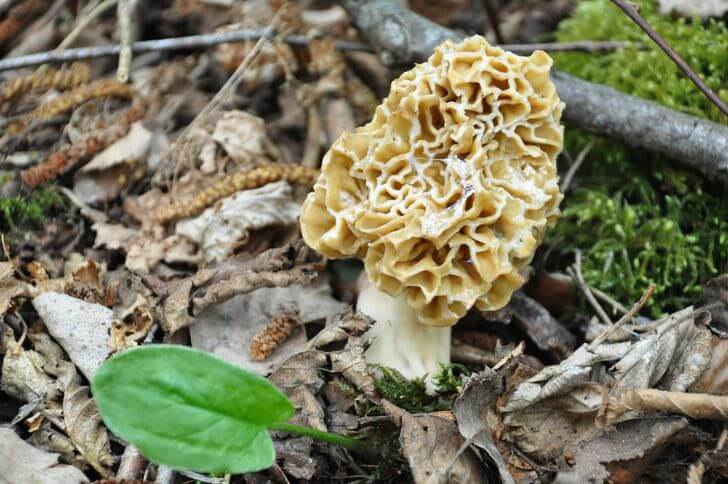
Are morels out in Indiana yet? Yellow morels are the most common types of Morels in Indiana. They pop out from mid-late April and peak season is during the 2nd-3rd weeks of May. What are the signs it’s morel season in Indiana?
You know it’s time to get your foraging tools when it’s spring and there is new life around you, flowers blooming and winter clothes are out and lighter clothes are on sale.
Identification:
New to the hunt? There are three ways you can identify yellow morels. First look at their honeycombed caps (pits and ridges). The cap should be yellowish gray and mostly longer or almost the same size as the stalk.
Second, morel mushrooms Indiana have a white stalk that is tightly fused to the cap. The whitish stalk may have an enlarged base.
Third, the last feature you should look at is the inside of the mushroom. Cut it in half and if it’s hollow from top to bottom, congratulations you have your first morel.
2. Wood Ear
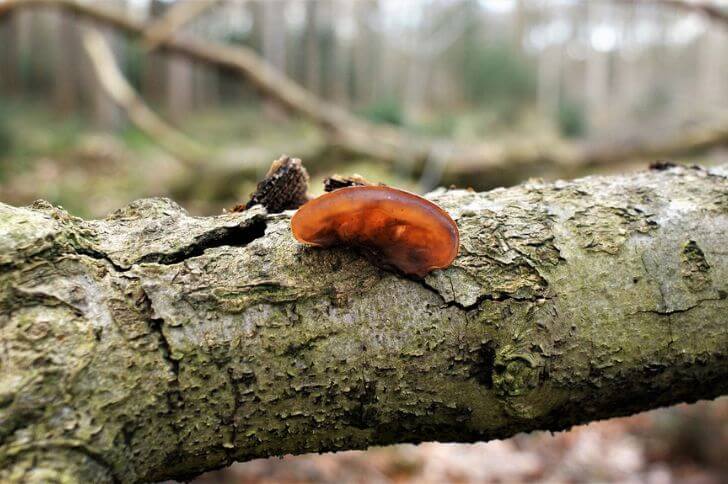
Wood ear fungi, also known as tree ear fungus, is a species of edible jelly fungus found in Indiana. Originating in East Asia, this dark brown or black mushroom is most commonly used in asia cuisine.
Identification:
Wood ear mushrooms can be identified by their irregular and wavy shape and rubbery texture. Additionally, they have a crunchy texture reminiscent of asparagus or artichoke hearts.
You can find them growing on fallen, rotting trees. How can you use wood ear fungus? Most foragers use them to prepare Mu Shu pork, fried rice and in soups.
3. Velvet Foot Mushrooms
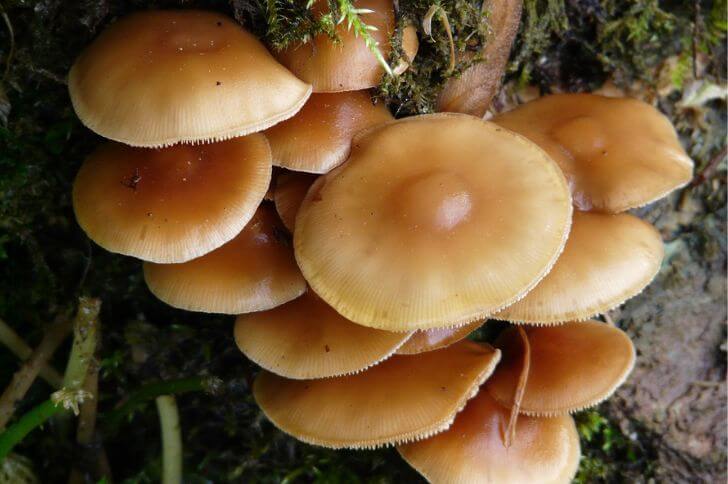
Velvet foot mushrooms are brown fungi that should be cooked whole due to their small size. Also called enoki, their mealy flavor makes them a great addition to eggs or soups.
Identification:
Velvet Foot mushrooms can be identified by their unique look and structure. The first telltale feature is the small caps and long curved stalk. Caps are light brown to tan while stalks are darker.
Underneath the cap, the crowded gills are narrowly attached to its stem. Velvet foot mushrooms have a white spore print. Additionally, when touching the stem the texture will remain velvet-like instead of becoming slimy like many other types of fungi do when handled.
Another sign that what you are looking at are enoki is they grow on standing dead oaks, beech, and ash. When these Midwest mushrooms are young and fresh, they have a distinctive smell that many describe as nutty or earthy.
4. Brick Cap
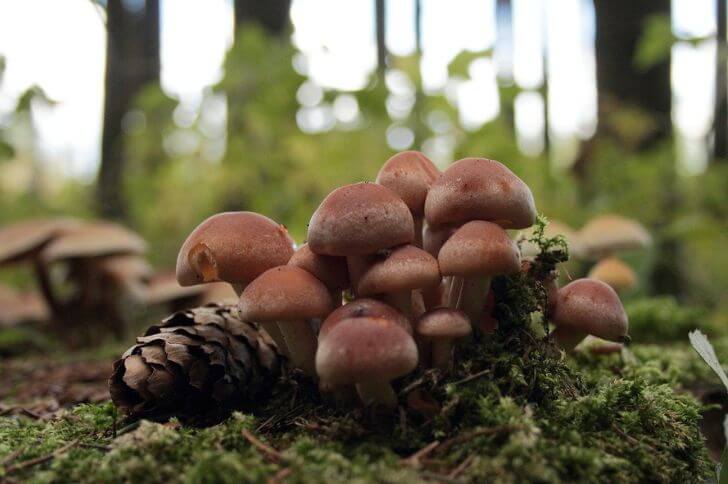
When foraging for mushrooms, it is important to accurately identify which species you have found. One of the most common types of mushroom in Indiana is the Brick Cap.
Identification:
They look like the velvet foot above except they grow in clusters on the ground. Brick cap mushrooms or chestnut mushrooms have brown convex caps. And, unlike enoki, their caps are dry and larger, growing to 4 inches in diameter.
Under the cap you’ll find purple brown crowded gills and a similar colored spore print. Where can you find brick cap mushrooms?
If you are looking for fall mushrooms in Indiana, chestnut mushrooms can be found on decaying or dead hardwood.
What do they taste like? I find them slightly bitter with a nutty taste. If you want a culinary adventure, you can’t go wrong with chestnut mushrooms.
5. Orange Jelly
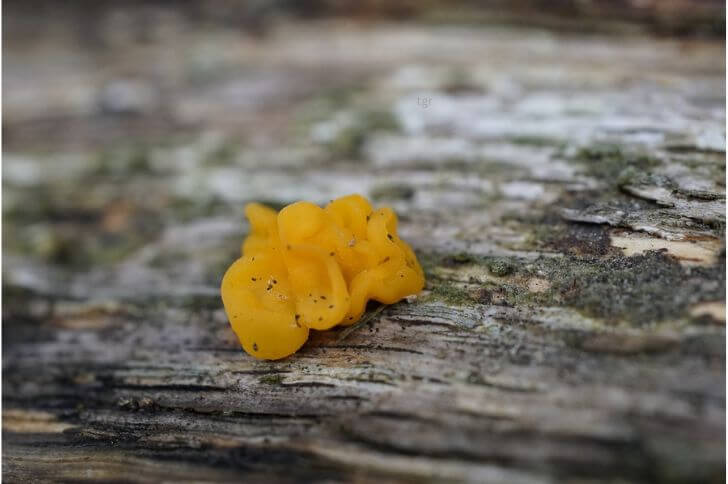
Orange jelly mushrooms, also called orange witch’s butter, are tasteless fungi that occur in stumps or rotting trunks of conifers.
Identification:
They are characterized by their bright orange-yellow color and spoon-shaped fruiting body. When can you find this fungus in Alabama? They are common in fall. Do I recommend them? Most foragers don’t give them a second look. They are tiny and tasteless, so no. Better spend your time looking for oysters.
6. Oyster Mushroom
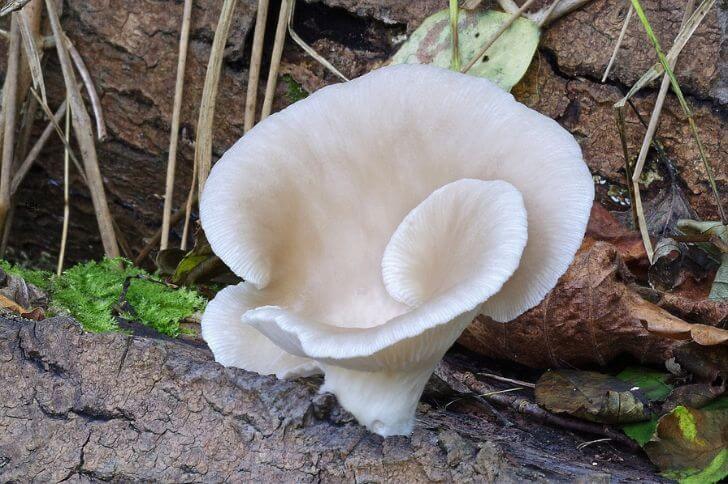
Are there oysters in Indiana? Yes, this white wild mushroom can be found all year round in areas that are warm and wet. Also, you can cultivate oysters at home.
Identification:
Oyster mushrooms, also known as Pleurotus ostreatus can be identified by their distinct shape, color and size.
The unique feature is the white to grayish fan-shaped cap. The cap ranges from 0.75 inches to 10 inches across and the gills underneath the cap are pale cream in color. When is the right time to pick them? Like other edible mushrooms of Indiana, you should pick younger specimens. As they age, oysters can become stringy and tough.
How to prepare oysters? They taste good fried or roasted. This brings out their smooth texture and umami flavor.
7. Amber Jelly Roll
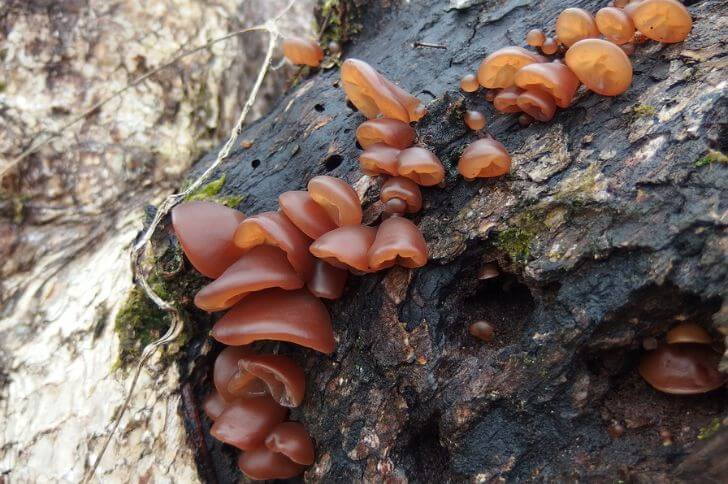
Amber jelly roll mushrooms are fun to forage and add color to wild mushroom dishes. These mushrooms, also known as willow brains, occur all year round in Indiana but are in abundance in fall and winter.
Identification:
Their distinctive fruiting bodies make it easy to identify them. They are dark brown and about 1 inch across. Each mushroom grows individually. When you touch one, you’ll notice the rubbery texture but not squishy.
Even when squeezed, the amber jelly roll retains its shape. How do you cook these fungi? Like wood ear fungus, this mushroom doesn’t have a distinctive taste.
But their blandness makes them ideal for many dishes. Try adding them to any stew or noodle dish.
8. Cantharellus Minor
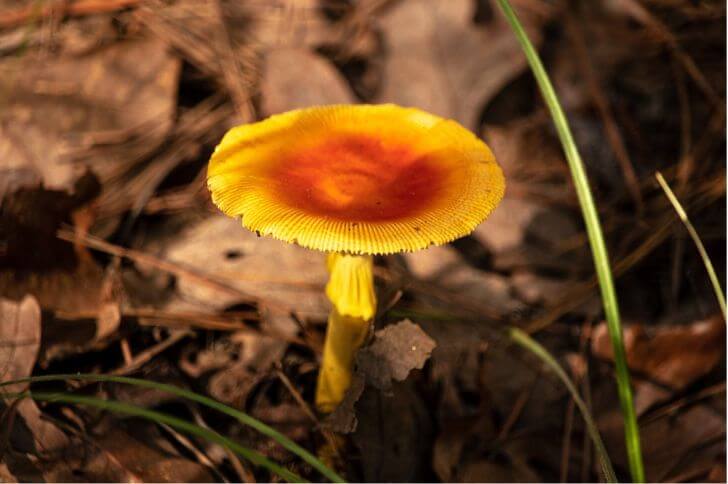
Common in Eastern North America states, the cantharellus minor is one of the smallest members of the chanterelle family. It’s also easy to identify.
Identification:
The fruiting body typically has a convex cap ranging from light yellowish to bright golden in color with prominent ridges. Its stem is usually pale yellow and long, giving it a funnel-shaped body.
In addition to its unique coloration, the cantharellus minor mushroom also produces a pleasant aroma that has been described as similar to apricots or sweet apples by some foragers. Furthermore, the taste of this species is considered mild yet pleasantly nutty and earthy when cooked properly.
9. Witch’s Butter
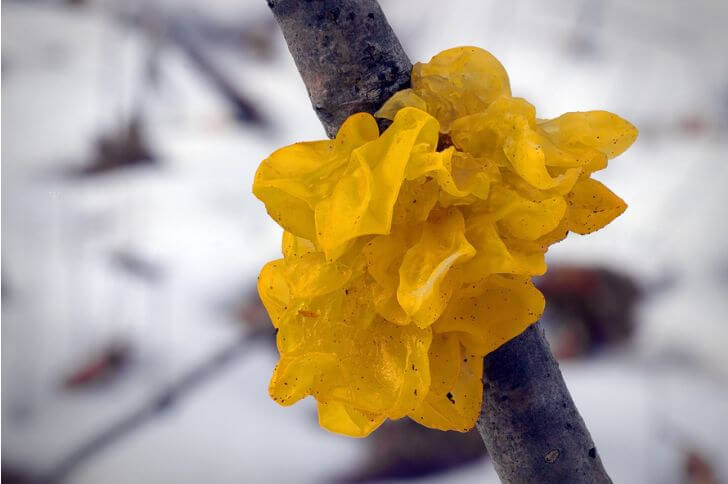
Another yellow mushroom of Indiana you should lookout for when foraging the woods is the witch’s butter. Scientific name Tremella mesenterica, they are an easily identifiable fungi.
Identification:
The bright yellow-orange color of the mushroom is unique and easily recognizable. They are smooth to the touch and brain-shaped, often with a stemless base. Witch’s Butter mushrooms can be found growing on dying logs all over Indiana, often after heavy rainfall.
Are witch’s butter edible? Yup, this odd fungus is edible and used to add texture to dishes. However, they don’t have a distinctive taste.
10. Turkey Tail Mushrooms
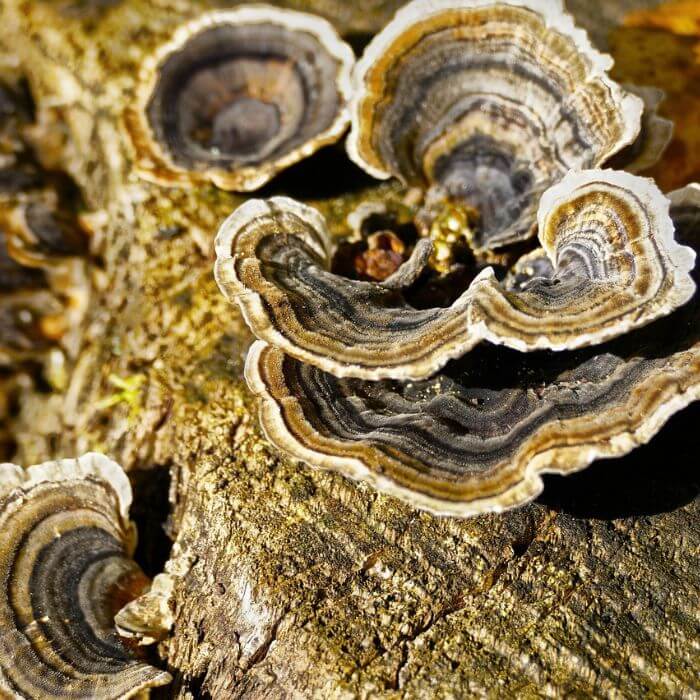
One of the most colorful mushrooms of Indiana is the turkey tail mushroom. Easily identifiable, this large bracket fungi is an all-year round type of fungi but mostly May through December.
Identification:
Identifying turkey tail mushrooms is relatively easy, as they are very distinctive in appearance and have some distinct characteristics.
The coloration of these fungi is what makes them so unique; their spore-bearing surface consists of concentric circles or bands of various colors, which range from shades of brown to gray to orange to cream. They often grow in overlapping fans with a velvet like texture.
Due to their leathery surface, turkey tail mushrooms are not edible. However, for centuries this mushroom has been dried and used in tea and you can add 1 teaspoon in smoothies.
11. Lion’s Mane
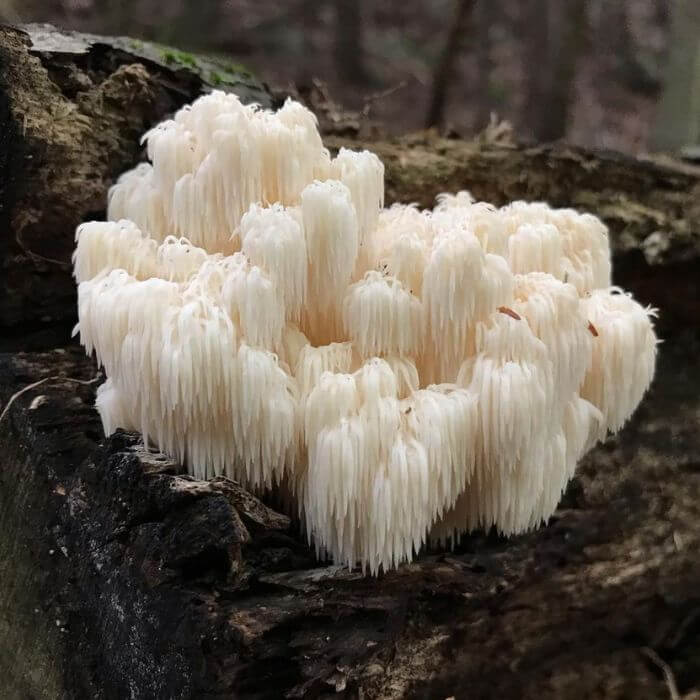
source: barredowlbrook
The lion’s mane mushroom is a unique and edible species of fungus that has been gaining popularity in recent years as a nutritious food source. This fungus can be found growing wild in different types of Indiana.
Identification:
With its cascading spines, it’s easy to identify this mushroom by sight. However, there are some important distinctions that must be made when it comes to properly identifying the lion’s mane mushroom.
The first thing to look for is the white coloration and spiny texture of the cap. The surface should have long shaggy strands that hang down from the top of the cap like spines. The mushroom is typically white. My favorite recipes include lion’s mane tacos, mushroom pasta, risotto, and also try a veggie soup.
12. Wood Blewit
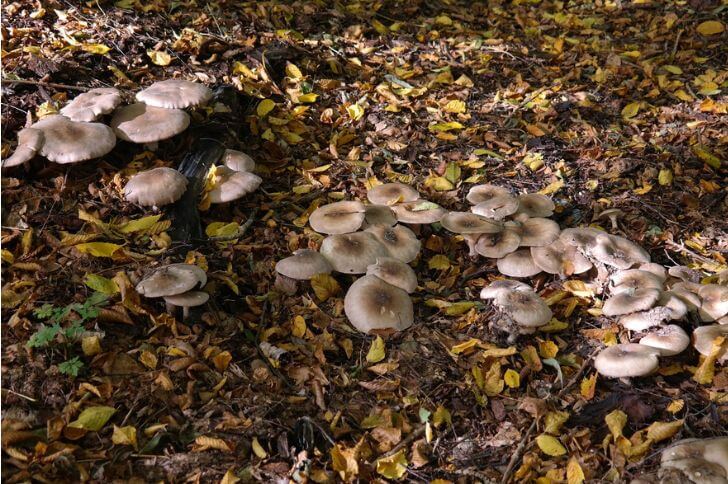
From risottos to pies, wood blewits are one of the tastiest edible mushrooms in Indiana. These mushrooms have a distinctive appearance that is easily recognizable in the wild, making them an ideal choice for amateur mushroom hunters.
Identification:
The most recognizable feature of the wood blewit is its deep purple cap with lighter tones towards the edges. The stem is usually bluish-purple and fibrous. Note the lilac, crowded gills.
Wood blewits also have a distinct smell that many describe as earthy or mushroomy. When cooked they have a meaty texture that goes well with other ingredients such vegetables, and cream sauces.
13. Fairy Ring Mushrooms
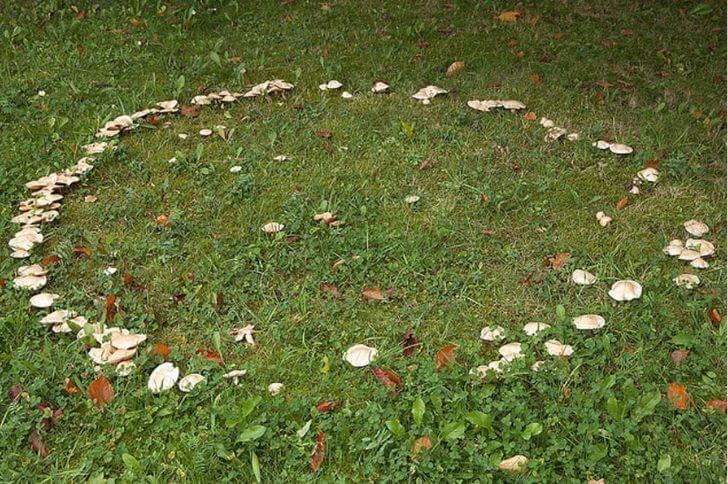
source: monique_empath
Fairy ring mushrooms are a common sight in gardens. They are easy to tell apart from other species.
Identification:
The most obvious trait of fairy ring mushrooms is their shape; they typically form a perfect circle or semicircle on the ground with an even distribution of mushrooms within it. Ring sizes vary. Other features include a tan convex cap and white gills on the underside of each cap.
Can you eat fairy ring mushrooms? Yes, they are edible and they have a slightly nutty taste.
14. Crusty Russula
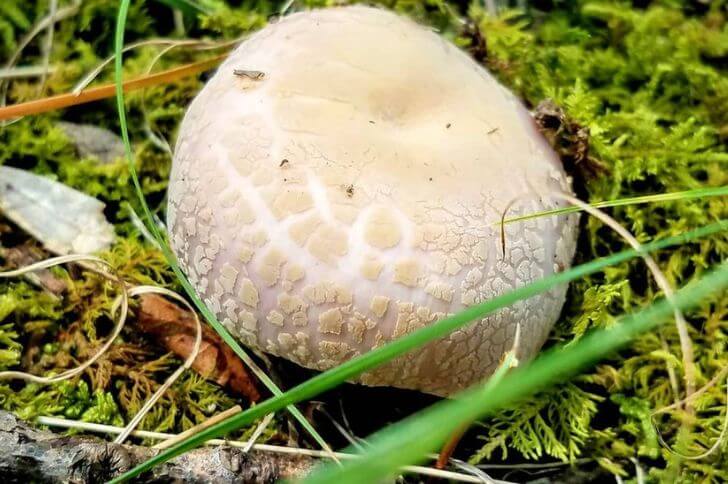
Source: wh1t3r0ck
Another white Indiana mushroom that is edible is the crusty russula. A member of the russula family, foragers love it for its mild flavor and thick flesh.
Identification:
These mushrooms pop on the ground near hickory and oak trees. They typically range from 2-5 inches in diameter with a yellowish brown almost flat cap.
As the mushroom matures the dry surface cracks and starts peeling, giving this russula its name. Their gills underneath will be white or off-white in color.
15. Red Chanterelle
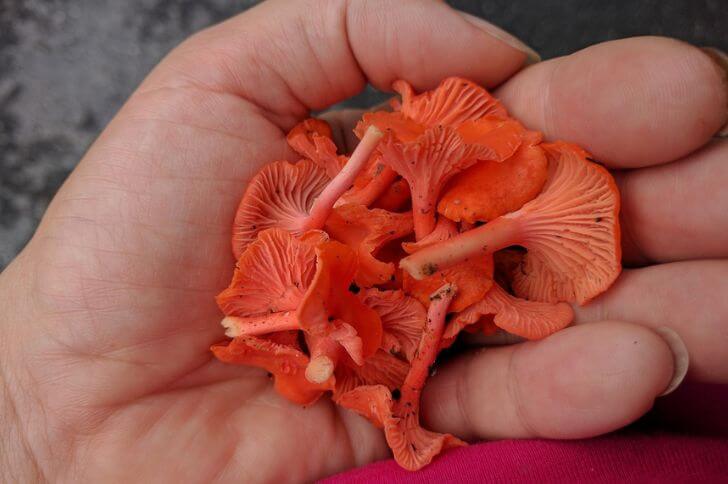
Beautiful and rare, red chanterelle mushrooms are a type of red wild mushroom that are prized for their unique flavor and texture.
Identification:
They’re easily identifiable by their bright orange-red color, funnel-shaped caps, and curved ridges on the underside of the cap. You can spot them growing in clusters when the other types of chanterelles start popping out.
Additionally, red chanterelles have a strong fruity scent. They are excellent in soups and souffles.
16. Indigo Milk Cap
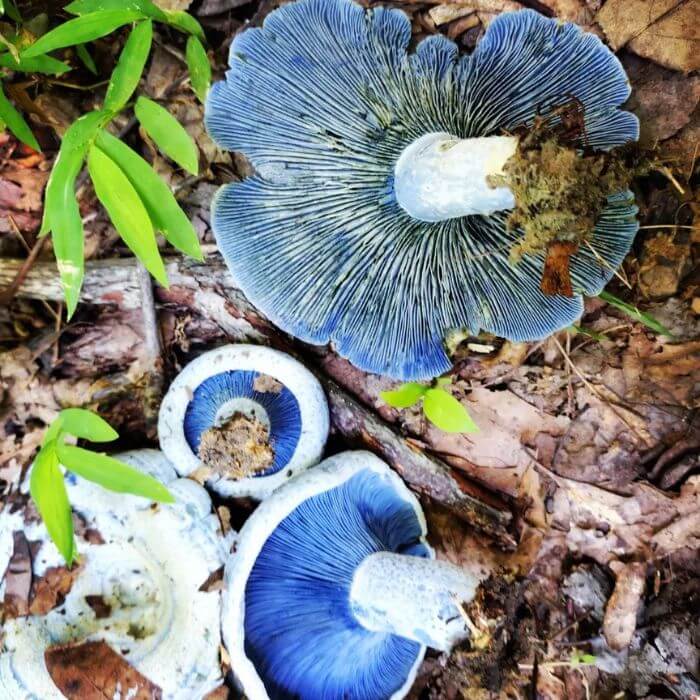
source: the_red_wv_hedgecrone
Indigo milky mushrooms are one of the most popular blue mushrooms of North america. They are a unique and visually stunning variety of mushroom that occurs from late summer through fall.
Identification:
These mushrooms are easily distinguishable due to their large size and blue coloring. Note, the blue color becomes intense when the mushroom is cut or bruised. They grow under white pines and tend to grow in the same place next mushroom season.
When harvesting, go for younger milk caps and cut off the stems. Blue milk mushrooms are used in a variety of dishes.
Related Read: Iowa Mushrooms
17. Hedgehog Mushroom
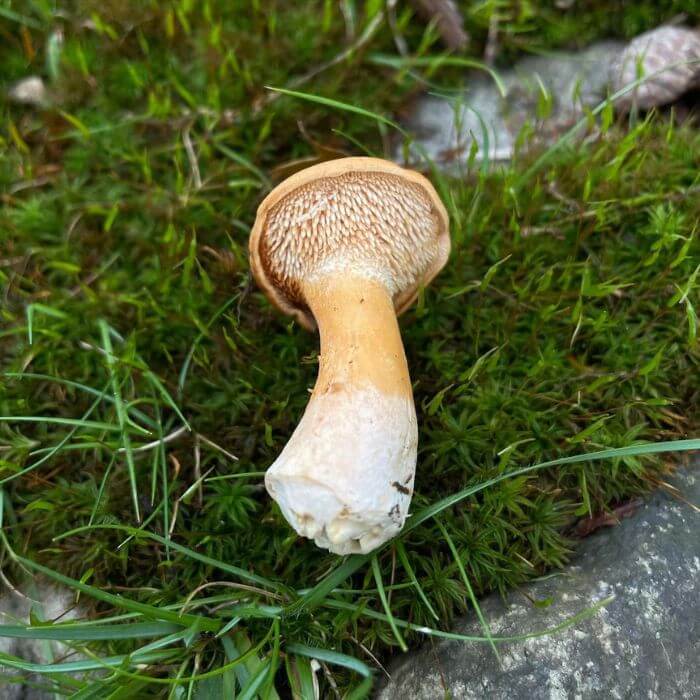
source: cakewalkcakewalk
Hedgehog mushrooms are an edible fungi that may be found in woods and fields.
Identification:
These fungi range in color from orange-brown to yellowish. The undercap of the mushroom is covered in small spines that resemble bristles on a brush – hence their name.
When young, these mushrooms will have tightly curled edges but when mature they will spread out more and appear flat. Additionally, hedgehogs grow gregariously and their caps become distorted, giving them a chanterelle look.
Can you cook sweet tooth mushrooms? Yes, you’ll love their earthy taste.
18. Giant Puffball
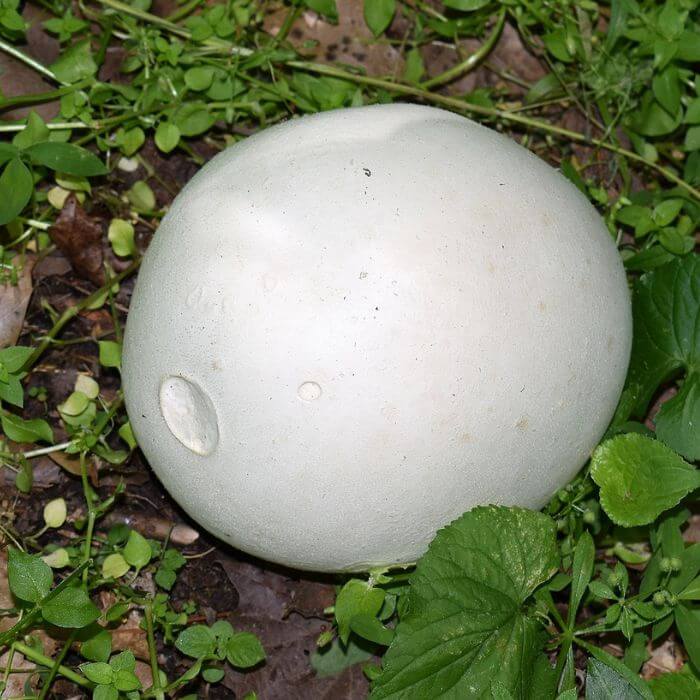
Giant puffball mushrooms are some of the most well-known and easily identified mushrooms in Indiana.
Identification:
To identify a giant puffball mushroom, look for its distinctive shape – they may be round or slightly oblong – and its size; they can range from softball sized to much larger.
The outside and inside should be pure white, not yellowing or browning at all, though it may have several small dark spots due to dirt contact. Giant puffballs are found growing on grassy fields from late summer through fall and are edible when still white inside.
19. False Russula
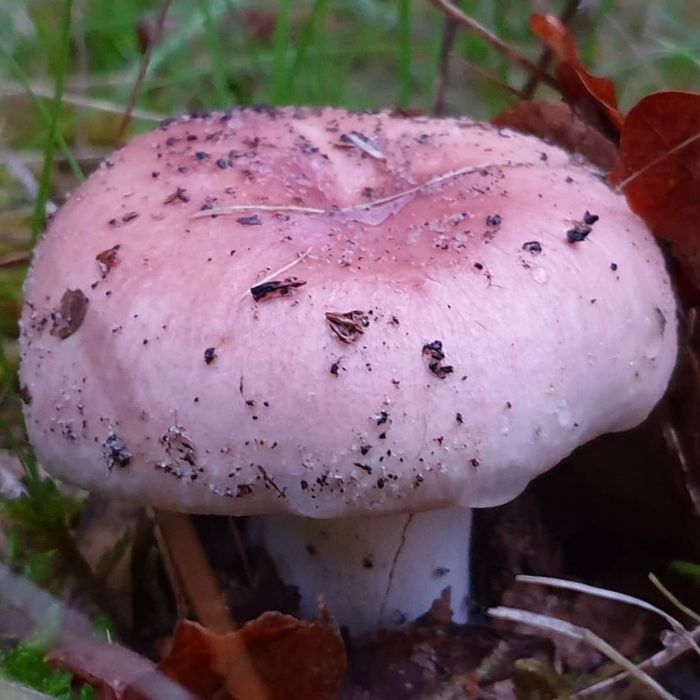
source: basslootheer
False russula are often misrepresented as inedible because of the ‘false’ part of their name. But, unlike other false types of mushrooms, this mushroom is edible.
Identification:
These mushrooms have sturdy stems with a white spore print, and a shallowly depressed cap that ranges from reddish to pinkish. It is slimy. cap color varies from yellowish-tan to grayish-green. They have decurrent gills that are an off-white and become pinkish with age.
False russulas grow under oaks. They are common from August-October. No distinctive taste.
20. Scarlet Cup Fungi
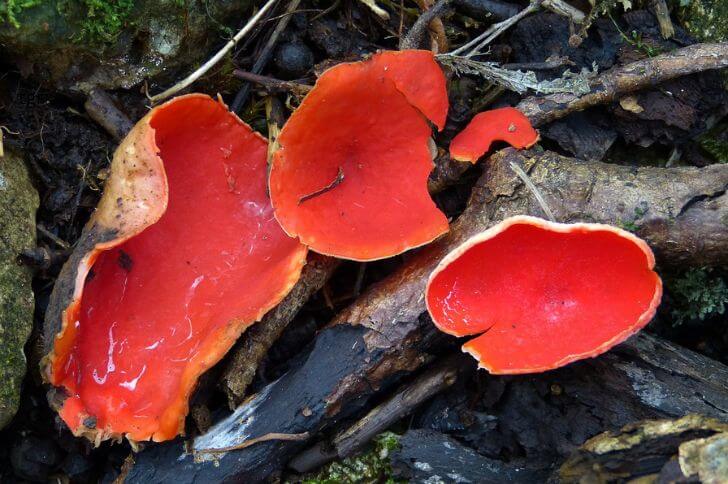
Scarlet cup fungi are clustered mushrooms that most foragers can identify even from afar.
Identification:
It is easily identified by its bright red color and distinctive cup-shaped structure. The outer surface of the fungi can range in color from salmon pink to orange, with a smooth texture that may have bumps.
The interior of the scarlet cup fungi has a bright red color. These small red Indiana mushrooms are decomposers; meaning they typically grow on rotting beech and elms.
In addition, this species of fungus can also be found growing on dead branches lying on the ground in shady areas or damp forests.
Are scarlet fungi edible? Yes, I recommend you fry in butter and enjoy the subtle earthy flavor.
21. Old Man of the Woods
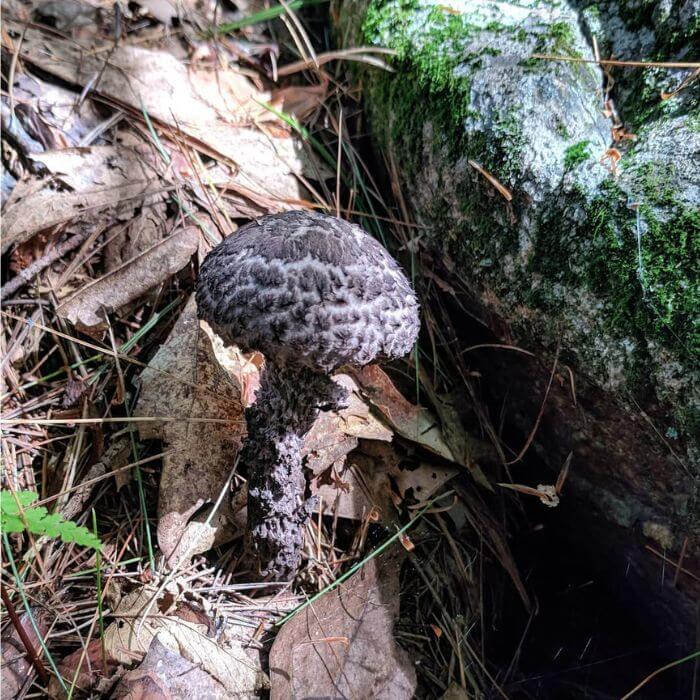
source: joyce_wuworks
I like this mushroom because of its weird name; it doesn’t sound like a mushroom. The Old Man of the Woods mushroom is an edible species that can be found throughout the Northern Hemisphere. Its scientific name is Strobilomyces strobilaceus.
Identification:
It’s easily identified because of its scruffy-looking fruiting body. It stands at about 5.5 inches with a canonical cap. Also, the gray fruiting body is covered by black scales that appear shaggy. Stipe is darker. Can you cook old man of the woods? Yes, some foragers enjoy them. I don’t.
For me they have a strange-look and an equally strange taste. Honestly it’s awful. But, if you want to try new things, try old man of the woods.
Inedible Mushrooms in Indiana
22. Amanita Muscaria
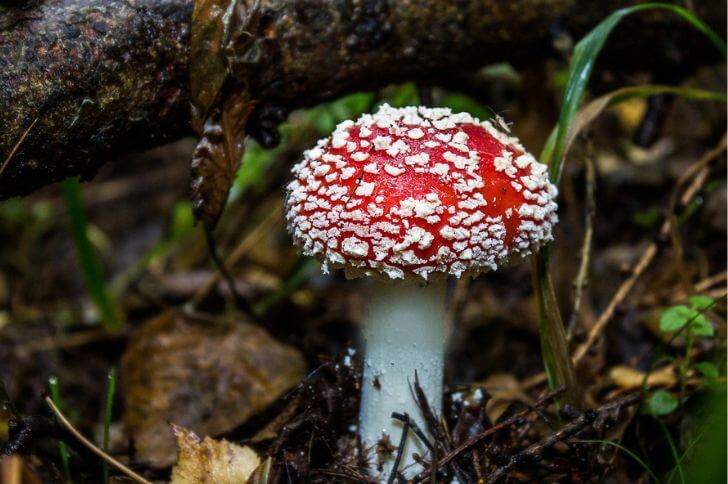
The amanita muscaria mushroom is a unique red fungi species that is native to North America. Also called fly agaric, it is one of most distinctive inedible Indiana Mushrooms.
Identification:
The most recognizable feature of this fungus is its bright white and red cap, which typically reaches diameters between 2-8 inches in length.
Its gills are white in color and the stem ranges from 2-7 inches tall with a basal bulb covered in small scales. Additionally, the fly agaric prefers moist areas with plenty of organic matter.
23. Clustered Bonnet
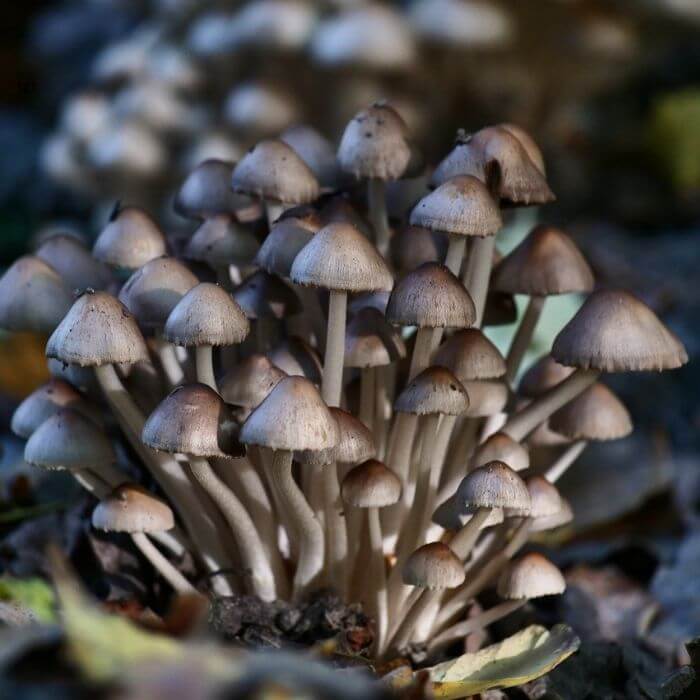
Clustered bonnet mushrooms can be identified by their distinctive features.
Identification:
The mushrooms have a unique umbrella-shaped cap that is reddish-brown and darker in the middle. Additionally, clustered bonnet mushrooms have a thin stalk that ranges in color from white to cream colored. When cut open, the flesh inside is whitish gray.
Like agarics, they are found in plant litter. Though they have not been classified as edible or inedible, we recommend you ignore clustered bonnets.
24. False Earthstar
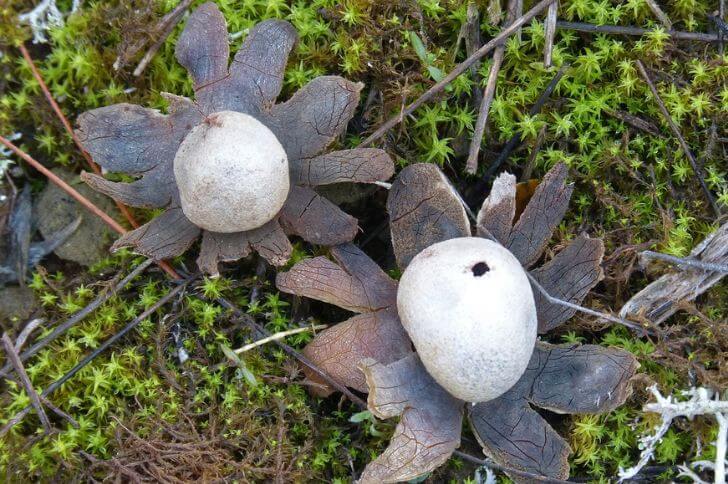
False Earthstar Mushrooms are a unique and often overlooked mushroom variety.
Identification:
False earthstars are small about 0.5-3 inches in diameter. Young fruiting bodies look like small puffball mushrooms. As they mature, the outer layer opens and splits up, forming pointed rays. The inner layer is white and solid. False earthstars are inedible.
25. Plums and Custard
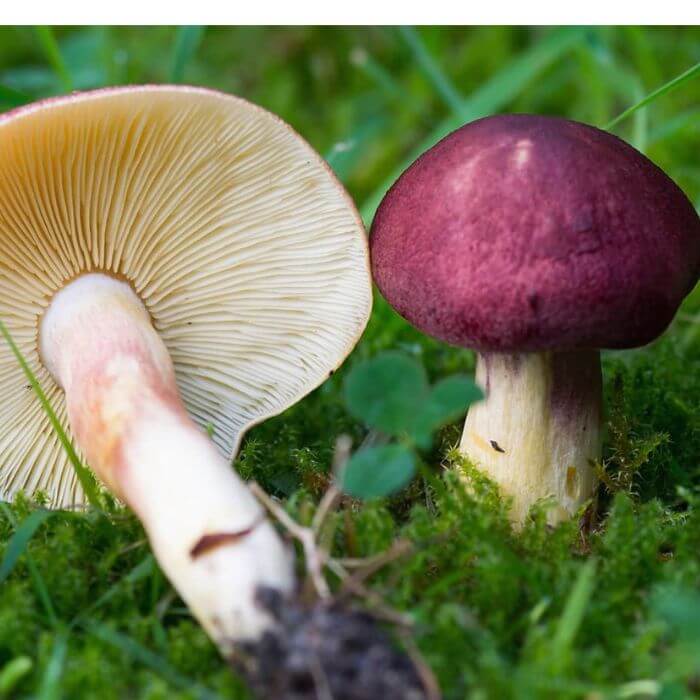
source: malakorpela
Plums and custard are one of the most beautiful inedible mushrooms in IA. They are an easily recognized fungus.
Identification:
The Plums and Custard mushroom has a soft cap with slightly inward curved edges. The cap is typically purple to red and yellow underneath.
They also have a 3-5 inches tall stipe. Plums and custard looks good on paper but why has it been categorized as inedible? Well, because it’s bitter with a taste that most describe as rotting wood. Wouldn’t want to put that in my mouth.
FAQs
Do chanterelles grow in Indiana?
Yes, different subspecies of chanterelles grow in Indiana including red chanterelles, yellow chantelles and cantharellus minor.
Where can I find mushrooms in Indiana?
Best places to look for mushrooms include woods, near streams, fields, parks, and state forests. Some mushrooms will grow on rotting trees while others grow on living trees.
Can you find Lion’s mane in Indiana?
Lion’s mane occurs in Indiana. Check around dead maple and beech trees
Final Thoughts:
Foraging for mushrooms is becoming increasingly popular with foodies who want to add another level of freshness and flavor to their dishes. It’s important to know what you’re looking for when harvesting any mushroom variety. The comprehensive list above will help you when foraging for mushrooms in Indiana.
Sources:
Hi There,
My name is Jenny. I’m the Chief Editor at Try Green Recipes and besides making yummy and healthy foods for my kids, grandkids, and friends. I’m new to the blogging world but I believe what I have to share is unique and will bring joy to your home. If you are adventurous and want try something tasty, let’s get started.

